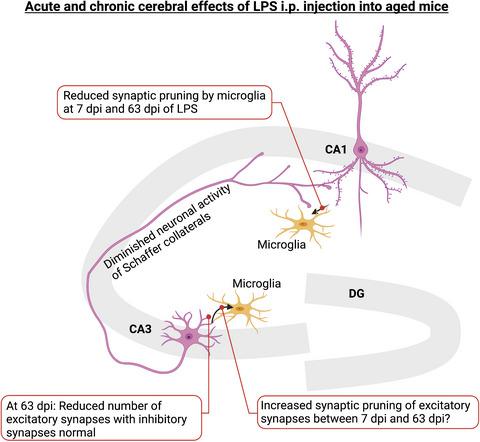当前位置:
X-MOL 学术
›
J. Neurochem.
›
论文详情
Our official English website, www.x-mol.net, welcomes your
feedback! (Note: you will need to create a separate account there.)
Systemic inflammation induced the delayed reduction of excitatory synapses in the CA3 during ageing
Journal of Neurochemistry ( IF 4.2 ) Pub Date : 2021-08-11 , DOI: 10.1111/jnc.15491 Tatsuya Manabe 1, 2 , Ildikó Rácz 1, 2 , Stephanie Schwartz 1, 2 , Linda Oberle 3 , Francesco Santarelli 2 , Julius V Emmrich 4 , Jonas J Neher 3, 5 , Michael T Heneka 1, 2, 6
Journal of Neurochemistry ( IF 4.2 ) Pub Date : 2021-08-11 , DOI: 10.1111/jnc.15491 Tatsuya Manabe 1, 2 , Ildikó Rácz 1, 2 , Stephanie Schwartz 1, 2 , Linda Oberle 3 , Francesco Santarelli 2 , Julius V Emmrich 4 , Jonas J Neher 3, 5 , Michael T Heneka 1, 2, 6
Affiliation

|
Sepsis-associated encephalopathy (SAE) represents diverse cerebral dysfunctions in response to pathogen-induced systemic inflammation. Peripheral exposure to lipopolysaccharide (LPS), a component of the gram-negative bacterial cell wall, has been extensively used to model systemic inflammation. Our previous studies suggested that LPS led to hippocampal neuron death and synaptic destruction in vivo. However, the underlying roles of activated microglia in these neuronal changes remained unclear. Here, LPS from two different bacterial strains (Salmonella enterica or E. coli) were compared and injected in 14- to 16-month-old mice and evaluated for neuroinflammation and neuronal integrity in the hippocampus at 7 or 63 days post-injection (dpi). LPS injection resulted in persistent neuroinflammation lasting for seven days and a subsequent normalisation by 63 dpi. Of note, increases in proinflammatory cytokines, microglial morphology and microglial mean lysosome volume were more pronounced after E. coli LPS injection than Salmonella LPS at 7 dpi. While inhibitory synaptic puncta density remained normal, excitatory synaptic puncta were locally reduced in the CA3 region of the hippocampus at 63 dpi. Finally, we provide evidence that excitatory synapses coated with complement factor 3 (C3) decreased between 7 dpi and 63 dpi. Although we did not find an increase of synaptic pruning by microglia, it is plausible that microglia recognised and eliminated these C3-tagged synapses between the two time points of investigation. Since a region-specific decline of CA3 synapses has previously been reported during normal ageing, we postulate that systemic inflammation may have accelerated or worsened the CA3 synaptic changes in the ageing brain.
中文翻译:

全身炎症导致衰老过程中 CA3 兴奋性突触的延迟减少
脓毒症相关脑病 (SAE) 代表多种脑功能障碍,以响应病原体诱导的全身炎症。脂多糖 (LPS) 是革兰氏阴性细菌细胞壁的组成部分,外周暴露已被广泛用于模拟全身炎症。我们之前的研究表明,LPS 导致海马神经元死亡和体内突触破坏。然而,激活的小胶质细胞在这些神经元变化中的潜在作用仍不清楚。这里,从两个不同细菌菌株(LPS肠道沙门氏菌或Ë。大肠杆菌) 在 14 至 16 个月大的小鼠中进行比较和注射,并在注射后 7 或 63 天 (dpi) 评估海马中的神经炎症和神经元完整性。LPS 注射导致持续性神经炎症持续 7 天,随后在 63 dpi 后正常化。值得注意的是,E后促炎细胞因子、小胶质细胞形态和小胶质细胞平均溶酶体体积的增加更为明显。大肠杆菌LPS 注射液优于沙门氏菌LPS 为 7 dpi。虽然抑制性突触点密度保持正常,但在 63 dpi 时海马 CA3 区域的兴奋性突触点局部减少。最后,我们提供的证据表明,涂有补体因子 3 (C3) 的兴奋性突触在 7 dpi 和 63 dpi 之间下降。虽然我们没有发现小胶质细胞对突触修剪的增加,但小胶质细胞在两个调查时间点之间识别并消除了这些 C3 标记的突触是有道理的。由于之前已经报道过在正常衰老过程中 CA3 突触的区域特异性下降,我们假设全身炎症可能加速或恶化了衰老大脑中的 CA3 突触变化。
更新日期:2021-08-11
中文翻译:

全身炎症导致衰老过程中 CA3 兴奋性突触的延迟减少
脓毒症相关脑病 (SAE) 代表多种脑功能障碍,以响应病原体诱导的全身炎症。脂多糖 (LPS) 是革兰氏阴性细菌细胞壁的组成部分,外周暴露已被广泛用于模拟全身炎症。我们之前的研究表明,LPS 导致海马神经元死亡和体内突触破坏。然而,激活的小胶质细胞在这些神经元变化中的潜在作用仍不清楚。这里,从两个不同细菌菌株(LPS肠道沙门氏菌或Ë。大肠杆菌) 在 14 至 16 个月大的小鼠中进行比较和注射,并在注射后 7 或 63 天 (dpi) 评估海马中的神经炎症和神经元完整性。LPS 注射导致持续性神经炎症持续 7 天,随后在 63 dpi 后正常化。值得注意的是,E后促炎细胞因子、小胶质细胞形态和小胶质细胞平均溶酶体体积的增加更为明显。大肠杆菌LPS 注射液优于沙门氏菌LPS 为 7 dpi。虽然抑制性突触点密度保持正常,但在 63 dpi 时海马 CA3 区域的兴奋性突触点局部减少。最后,我们提供的证据表明,涂有补体因子 3 (C3) 的兴奋性突触在 7 dpi 和 63 dpi 之间下降。虽然我们没有发现小胶质细胞对突触修剪的增加,但小胶质细胞在两个调查时间点之间识别并消除了这些 C3 标记的突触是有道理的。由于之前已经报道过在正常衰老过程中 CA3 突触的区域特异性下降,我们假设全身炎症可能加速或恶化了衰老大脑中的 CA3 突触变化。











































 京公网安备 11010802027423号
京公网安备 11010802027423号